
On November 2, 2025, Federal Reserve Chair Jerome Powell expressed deep concerns about the potential impact of artificial intelligence (AI) on the job market. His comments came amid an ongoing AI boom, which he emphasized is not a speculative bubble but a genuine economic force that could ‘absolutely’ disrupt employment stability. These concerns coincide with the Federal Reserve’s recent decision to cut interest rates in response to broader worries about the health of the labor market.
Jerome Powell’s Core Concerns on AI and Employment
Jerome Powell has been vocal about the potential threats AI poses to the job market. In his remarks as Federal Reserve Chair on July 5, 2025, he cautioned about the technology’s potential to reshape labor demands, although he did not specify which sectors would be most affected. This warning was not an isolated sentiment, but rather part of a broader narrative of concern Powell has been articulating about the impact of AI on employment.
On November 2, 2025, Powell expressed deep concern about the broader effects of AI on the job market, particularly the uncertainty it introduces to workforce planning and economic forecasts. He stated unequivocally that AI could ‘absolutely’ affect the job market, a sentiment he had previously shared in his comments on October 29, 2025. This definitive yet measured tone underscores the gravity of his assessment and the potential implications for the labor market.
The AI Boom: Not a Bubble, But a Real Economic Force
Contrary to some views, Powell asserted on October 29, 2025, that the surge in AI investment is not a speculative bubble, but a genuine boom. He cited the sustained capital inflows into AI technologies as evidence of their long-term viability. This perspective implies that the impacts of AI on productivity and innovation are likely to be enduring, rather than fleeting.
Moreover, Powell linked the stability of the AI boom to potential shifts in the job market. He suggested that the ongoing investment in AI could ‘absolutely’ influence employment patterns, indicating a measured optimism about the potential benefits of AI, while also acknowledging the potential risks.
Federal Reserve Actions Amid Labor Market Worries
In response to concerns about softening labor market conditions, including rising unemployment risks, the Federal Reserve announced an interest rate cut on October 29, 2025. This decision reflects the central bank’s proactive approach to supporting job growth in an era of technological disruption. Powell’s comments on the potential impact of AI on the job market underscore the importance of such policy measures.
The Federal Reserve’s deliberations on October 29, 2025, highlighted job stability as a central concern. This focus reflects the interplay between labor market vulnerabilities and the rise of AI, with the potential for technological disruption to exacerbate existing employment challenges.
Gen Z Hiring Challenges: Beyond AI Displacement
While AI poses potential threats to the job market, it is not the only factor contributing to employment challenges, particularly for Gen Z. On September 21, 2025, Powell and top economists agreed that Gen Z’s hiring difficulties are real and characterized by persistent scarcity of entry-level jobs. However, they clarified that these challenges stem from structural factors like economic cycles and skill mismatches, rather than AI displacing entry-level jobs.
These structural challenges, such as prolonged job searches and underemployment, are specific struggles faced by Gen Z. The consensus among Powell and other economists on September 21, 2025, affirmed these difficulties without attributing them to automation.
Broader Economic Implications of Powell’s Warnings
Powell’s cautious warning on July 5, 2025, about AI’s potential to take jobs calls for policy adaptation to mitigate widespread displacement. His deep concerns about AI’s effects on the job market, expressed on November 2, 2025, could influence inflation and growth projections. These warnings are connected to the rationale for the October 29, 2025, rate cut, illustrating that the health of the labor market is a pivotal factor in Federal Reserve strategy amid AI-driven changes.
Consensus Among Economists on Labor Realities
On September 21, 2025, Powell and top economists recognized Gen Z’s real hiring difficulties, emphasizing data on youth unemployment rates. They agreed that AI is not the primary culprit for entry-level job losses, with other factors like post-pandemic recovery dynamics playing a significant role. This consensus shapes expectations for future labor policies and helps to balance the narrative on the impact of AI on the job market.
More from MorningOverview